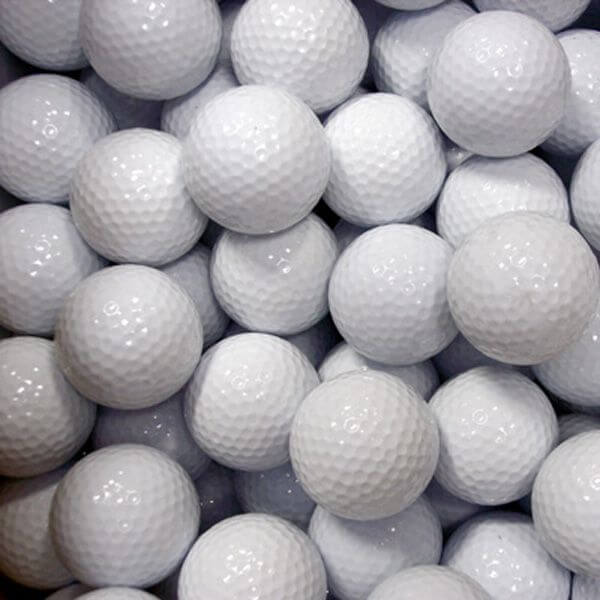
GOLF BALLS BUYING GUIDE
| Anonymous Golfer
The golf ball is the only piece of golf equipment you use on every single shot. This fact makes buying the right golf ball tremendously important. It only makes sense that you should have something that fits you, just like your clubs. We’re going to break down four major components to a golf ball and how they relate to choosing what’s right for your game.
#1 – GOLF BALL TYPES
Golf balls can be broken into three main categories: distance, spin control, and Tour performance (also called premium). Some golfers are looking to hit the ball as far as they can to make the game easier, that is where distance comes in. Others are looking to eliminate that big hook or slice so spin control balls are right for them. Tour performance is for golfers who want the complete package. They get the distance they need with a ball they can control and spin to create the shot they need depending on where they are on the golf course. Here are the details on the characteristics of each of these three types.
- Distance golf balls typically have a larger core and thinner cover to help boost yardage, especially from the tee box. Think of the core like the engine of the golf ball. The core is what makes the ball go. By combining a larger core with a thinner cover, your swing activates the core and the ball reacts faster off the club face, launching the ball with maximum speed. Srixon Soft Feel (there’s a women’s version available as well), Callaway Superhot, and Titleist Velocity are popular examples in the distance category.
- Spin control golf balls are designed to help you hit the ball straighter. Their goal is to cut down on the excessive side spin that causes hooks and slices for amateur golfers. Think of these along the same lines of a game improvement club, they’ll help make your shots just that much better if you struggle with spin. The popular Bridgestone e6 Speed and e6 Soft are perfect examples of a spin control golf ball.
- Tour performance golf balls are the ones used by the best golfers in the world. They feature multiple layers designed to interact with each other for optimal distance, spin, and feel. Each layer is activated based on how fast you swing, which depends on which club you’re using. This is what allows you to get minimal spin and maximum distance with your long clubs along with maximum spin and incredible control around the greens. Tour performance balls include Titleist’s Pro V1, Pro V1x, and AVX, the Callaway Chrome Soft and Chrome Soft X, and TP5 and TP5 X from TaylorMade.

#2 – GOLF BALL LAYERS: BEYOND THE DIMPLES
There are two constructions when it comes to the layers of a golf ball. You have two-piece golf balls and multi-layer golf balls. Multi-layer balls can have three, four, or even five layers. The number of layers changes the way the golf ball plays.
- Two-piece golf balls are usually preferred by beginners, high-handicap golfers, and golfers with slower swing speeds. They have a large core and thin cover making up the two layers. This construction maximizes the amount of energy the club transfers to the ball, powering your shots forward for greater distance.
- Multi-layer golf balls are used by mid-to-low handicappers and those golfers with faster swing speeds. A single golfer does not have a single swing speed. That is what makes the different layers in these balls so important. Your fastest swing will activate every layer right down to the core to create the distance you need. A shorter shot where you don’t swing as fast only activates the outer layers to create the spin and control to stop the ball quickly on the green. All these layers combined also create the feel and ability to shape shots that experienced golfers love.

#3 – COVER
Golf balls come with one of two types of covers: Surlyn or urethane.
- Surlyn is an ionomer resin created by DuPont and it is the most common cover for golf balls. It is extremely durable and resistant to scratching. Surlyn has been used as a cover for golf balls since the 1960s and is found on practically all non-Tour level balls because it delivers efficient energy transfer to maximize distance.
- Urethane is softer than Surlyn for more feel and feedback. While it is not quite as durable, it is used on higher-end multi-layer golf balls because it creates more spin and control in the short game. This feel and performance are generally preferred by more skilled golfers.

#4 – FEEL
Since picking the right golf ball is so much about personal preference, feel is incredibly important. This is where compression comes into play. When you hit your ball with a club, it deforms with that impact. That temporary change of shape is what springs the ball forward when you hit it. Lower compression golf balls deform more, allowing players with slower swing speeds to create that spring-like effect that generates more distance, reduces spin, and results in straighter shots. This is why lower compression balls feel so soft. High compression balls don’t deform so easily. They require faster, harder impact in order to change shape. Golf balls used by more skilled golfers with faster swing speeds are usually higher compression to activate the inner layers of the ball.
Compression ratings have undergone some changes over the years. Not all that long ago, every golf ball had a compression rating listed. Now, that information is not as easy to find. There are two reasons why manufacturers do not put as much emphasis on the actual rating number anymore. The first is technology. With the latest materials and construction, manufacturers can make a golf ball feel softer than it actually is. A ball may have a compression rating of 75, but through the newest construction, they can make it feel and play softer than the actual rating number. The other reason is there is not a universal test for compression. Each manufacturer may rate compression using a different test. So a golf ball that rates a 75 on one manufacturer’s test may rate as a 70 or 80 on another. Comparing compression ratings can be difficult when there is no universal rating system. For a deeper dive into why golf ball compression ratings are not as important as they once were.
Now that you’re equipped with these handy tips on what to look for when purchasing golf balls, check out our expansive selection and choose the best ball for your game!

Leave a comment
Your email address will not be published.